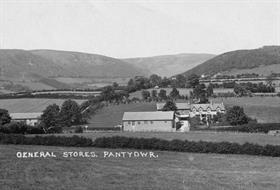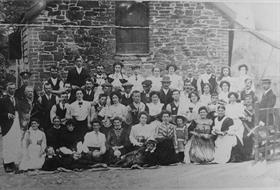A Shop Called Pantydwr
There was an established village on the hillside above St Harmon in the 14th Century but Pant y dwr is of much more recent origins. In the first half of the nineteenth century it consisted of a few dozen farms and cottages scattered around and on the flanks of Cennarth hill. The area was known as Cennarth, in the parish of St Harmon in the ancient cantref of Gwerthinion. Pant y dwr appears on the 1833 Ordnance Survey map as a homestead, a homestead which was also a shop, selling seed, tools, cloth and local farm produce. There was a similar shop in St Harmon and later small shops would open up at Sychnant and Eisteddle and Tylwch.
Birth of a Village
The village gradually coalesced around the shop. Carpenters, shoemakers and labourers without land or skills began to settle around the shop and on the common land bordering the road. They lived in one-roomed thatched hovels to begin with, shared with their pigs and hens, improving and rebuilding when they could, strengthening and enlarging, making things better year by year. About a third of the population died before their eighteenth birthday. Another third lasted up to their 60s and the rest sometimes into their 90s. Everyone lived on barley or oat bread and buttermilk. All grew potatoes and other roots. The better-off could afford some eggs, butter and a little meat.


A Jones Dynasty
The shop was owned by John Jones from Llanafan Fawr and over the next 150 years he and his descendants created a business that dominated the commercial life of the parish. The business really took off when the railway arrived in 1864 and brought the world to Cennarth. Folk who previously had been no further than local market towns were now connected to Cardiff or Aberystwyth or Blackpool. At 947 feet, this was the highest point on the line. A station was built and named ‘Pant y dwr’. Now new life and vitality flowed into the village via the railway, the sidings and the shop. The old self sufficient ways began to break down. There was now a demand for bricks, fuel, fencing and groceries. Tailors, dressmakers and blacksmiths moved in and a community began to grow around the shop, the station and the village pub.
In the 1860s there were eight servants living and working at the shop and a parallel farming business had been developed, supplying the shop with produce. By the end of the century there were 12 people living at the stores, as it was then known, including a milliner, a leather currier and a farm bailiff. A photograph from around that time depicts a gathering of 41 shop and farm employees
Anne the Shop
Anne Jones was one of the second generation to run the shop and her entrepreneurial skills helped to bring the business into the twentieth century. Branches were opened in Nantgwyn, Bwlch y sarnau and Rhayader and a grocery van served the outlying villages. The shop advertised itself as ‘ Draper,Grocer and Ironmonger; flour, seed and provender merchant; supplier of lime,coal, manure. Funerals completely furnished. It also acted as the village post office. When Anne Jones died in 1911 aged 69 the funeral procession between the shop and Sychnant Chapel was a quarter mile long. Her obituary said ‘ The late Mrs Jones was well known and most popular throughout mid Wales. The poor of the district have always a place in her heart.’



Decline and Fall
Jack and Dilys Evans took over the running of the farm in the 1950s and the family continued to run the shop until the 1970s. About that time came the age of self- service supermarkets and agricultural warehouses dealing direct with the public. Slowly and inexorably village shops throughout the country began to close. The Pant y dwr shop and post office remained open until the 1980s and eventually moved to Edward and Ruth Woods premises at Pontprensych for a time but closed in 2008, when the post office service was withdrawn. The old shop was sold to become a house, but is still known as The Stores and the adjacent living quarters were sold separately and renamed Amos Cottage. Now the only remnant of that once-great enterprise is a two-hour post office session and a small table of groceries every Wednesday morning in the village hall.
© PB 2016
Sources
Census Returns
Annual Voters Lists
Powys Archives (Acc 1934)
Brecon and Radnor Express 10 August 1911.